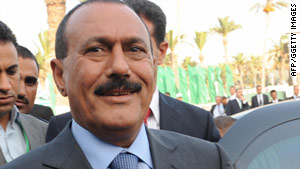Official: Behind scenes, U.S. prodding Yemen to confront al Qaeda

Washington (CNN) December 29, 2009 -- Updated 0310 GMT (1110 HKT) --
"Solid intelligence" from U.S. and Yemen services finally persuaded Yemeni President Ali Abdullah Saleh last summer to accept increased help in fighting al Qaeda in his country, a senior U.S. official told CNN.
After years of pressure from the U.S. to crack down on al Qaeda in Yemen, Saleh was persuaded to accept help after he was presented with intelligence that al Qaeda "was targeting inner circle Yemeni leaders" and that there were a growing number of terrorist training camps in Yemen, the official said.
The official, who declined to be named because of the sensitivity of the situation in the wake of the attempted attack on Northwest Airlines Flight 253, detailed to CNN growing U.S. involvement in fighting al Qaeda in Yemen.
Both Gen. David Petraeus, head of the U.S. Central Command, and John Brennan, President Obama's counterterrorism adviser, visited Saleh in Yemen last summer to lay out the terrorist threat. The official said after those meetings, it was clear that Saleh was finally seeing the threat as "much more alarming" than he had previously.
Petraeus had already been laying the groundwork with the Obama administration that al Qaeda in Yemen was a growing threat, and Petraeus was setting up U.S. military assistance efforts including the use of special operations forces inside Yemen to help train Yemeni forces on counterterrorism operations, the official said.

Al Qaeda 'safe haven' in Yemen
In part, the U.S. believes Saleh turned around at that time also because of pressure from Saudi Arabia and other Persian Gulf nations, especially after the attempted assassination of Saudi Deputy Interior Minister Mohammed bin Naif by a suspected al Qaeda operative coming from Yemen. The U.S. also provided additional intelligence that al Qaeda was planning to strike targets in the capital city of Sanaa.
The Pentagon is spending about $66 million this year to provide Yemen with security and military assistance including training Yemeni counter-terrorist forces.
But the official and other administration sources confirmed that behind the scenes, much more is going on. U.S. military and intelligence agencies are providing not only training, but weapons and intelligence-targeting information.
This official, as well as other administration officials, have continually declined to say whether U.S. warplanes, drones or cruise missiles have been used in several recent strikes against al Qaeda targets in Yemen.
Concerns about the growing al Qaeda safe haven have been made more severe by the declining security situation in Yemen. The official noted there is a rebellion by Huti tribes in the north and secessionists in the southern tribal areas.
There also has been declining oil production, which has led to budget cuts in Yemen's security apparatus.
Other factors that have made Yemen a concern include a growing youth population, hundreds of thousands of Somali refugees and an increasing water shortage that is exacerbated by the growing production of the drug khat, which contains an amphetamine-like substance and requires more water than many other crops.
There is also a substantial arms and drug smuggling network, with intelligence indicating some arms shipments to Hamas via Sudan and then Egypt.
The official said not only are there senior al Qaeda leaders "putting down roots" in Yemen, but next door Somalia has now become home to al Qaeda in East Africa, which has ties to terrorists in Yemen, as well as to senior al Qaeda leaders across North Africa and in the Pakistani border region with Afghanistan.

No comments:
Post a Comment